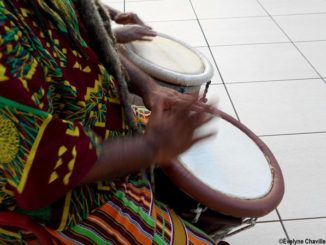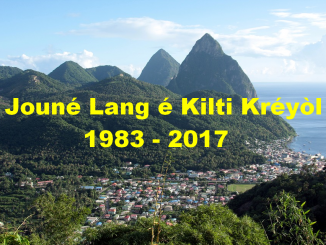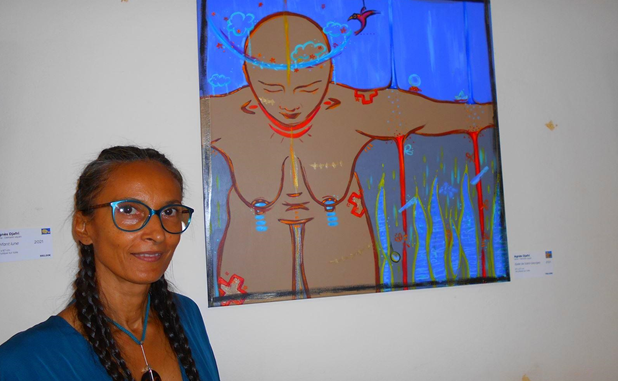
From April 30 to May 22, 2022, Agnès Djafri presented her exhibition entitled “Croisement entre deux vagues” at the town hall of Baillif. Kariculture had the opportunity to discuss with this painter born to a Guadeloupean mother and an Algerian father who describes her art as a free and intuitive figuration.

Kariculture : How did you get this opportunity to exhibit at the Baillif town hall?
Agnès Djafri : It was an invitation from the town hall of Baillif which, from now on, wants to organize art exhibitions in its reception hall where there are picture rails, it’s big, it’s airy with a beautiful light. I am the second on this list, before me, there was Joselita Guayroso who invited me in her turn and I shared this opportunity with other artists because I think, like Madam Mayor, that it is important that art moves, that everyone has access to art, whether it is for the Baillif audience or Basse-Terre and the surrounding area, it’s good not to stay only in the Pointe-à-Pitre urban area or Le Gosier where we all know each other, we see the same people all the time, it’s fine, but it’s also good to go elsewhere.
Kariculture : Why is this exhibition called “Croisement entre deux vagues”?
A. D. : Since March 2022 until today, I have participated in about 8 art events. It was really between two, I was at Valombreuse in an art gallery, I was at the Arawak Hotel and, at the same time, I was leaving an artist’s residence with the Departmental Council of Guadeloupe at the Fort Fleur d’Épée. So, I was in this very “bushy” world artistically speaking but I had this need that people follow me in my wake and to help them discover my world because every time I exhibit, the great moment is the meeting with the audience, this moment when there are people who see things that I did not necessarily see, that were in my unconscious, emotions that arise in these people, needs to share that they have… These are really precious moments and I got a little carried away by this movement, by this wave to Baillif, and I know that this is not the end of the season for me…
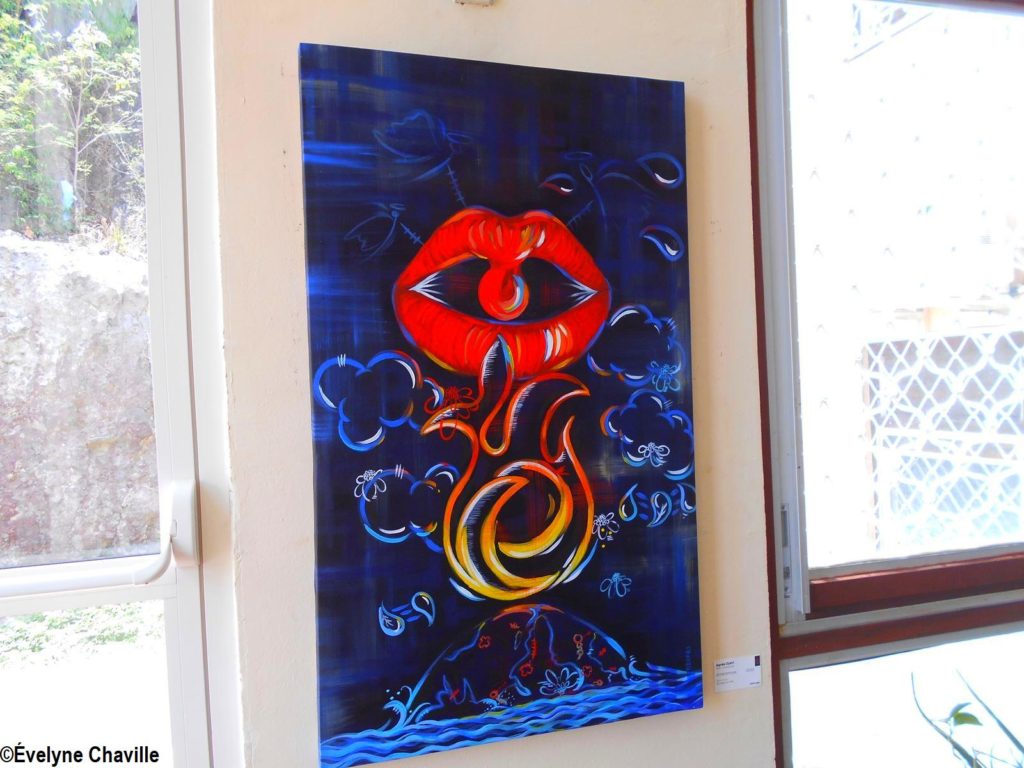
Kariculture : How many works make up this exhibition?
A. D. : There are about a dozen paintings. It’s a retrospective because I start the exhibition with paintings from 2018 to 2022 to show precisely to this audience that doesn’t know me and that I don’t know either, the work I have done over the past few years. It’s a form of presentation. It was necessary, whatever the exhibition, that I tell a story. I presented my work on painting, poetry and philosophy, these are my major fields of interest.
Kariculture : How is the audience? Is it shy?
A. D. : The audience is shy, for the moment, because it’s not a classic or usual exhibition space, it’s only the 2nd exhibition so people are not used to it yet, but at the opening, there were many guests, many artists from the region who came. I don’t have a balance sheet of the number of visits because I’m not there every day, I live in Le Gosier, I’m there once a week but these are interesting encounters and it’s necessary. I think that even if I’m not there, the paintings speak for themselves, I have words in the guestbook, sometimes people leave me phone numbers so that I can contact them for my next exhibition, to follow me.
Kariculture : Do you give priority to promotion rather than sales? Do you make yourself known first?
A. D. : It’s a combination. In fact, it’s mostly meeting people. When you are an artist, you are often alone in your studio, loneliness is part of your way of living and being, I am very happy about it, but there is this other moment, when you show your work and this moment of sharing is happiness.
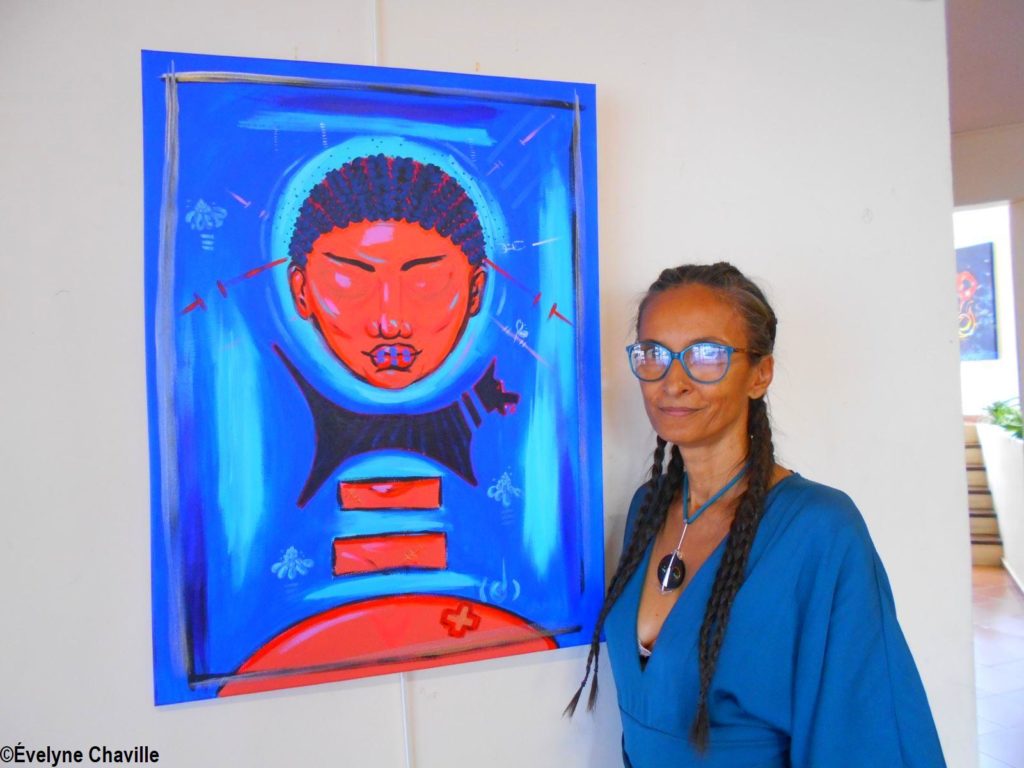
Kariculture : That’s when the works start to live…
A. D. : Exactly! it’s really priceless. Afterwards, we make sales, the work continues its personal history with someone else. I keep in touch with the buyers very often. I remember I sold my first painting to Luxembourgers who spent some time in Guadeloupe, I may have been in high school at the time, I don’t remember, but I started selling very early.
Kariculture : We are in a period of Covid or post-Covid, we don’t really know, and you manage to have several exhibitions, to be always between two waves, two waters, how do you explain that? Do you create the event?
A. D. : I create the event, in a way. When, I restarted exhibiting in 2018 with the Pool Art Fair, I did it every year this Pool Art Fair, even during the lockdown period when it was held in 3D. I also opened my studio and I invited artists to do the same, I was really dynamic and I didn’t have any negative feelings from that period. It was a period that was different but very enriching so when I opened my house to the public, I received people wearing masks but they were happy to be still connected with art.
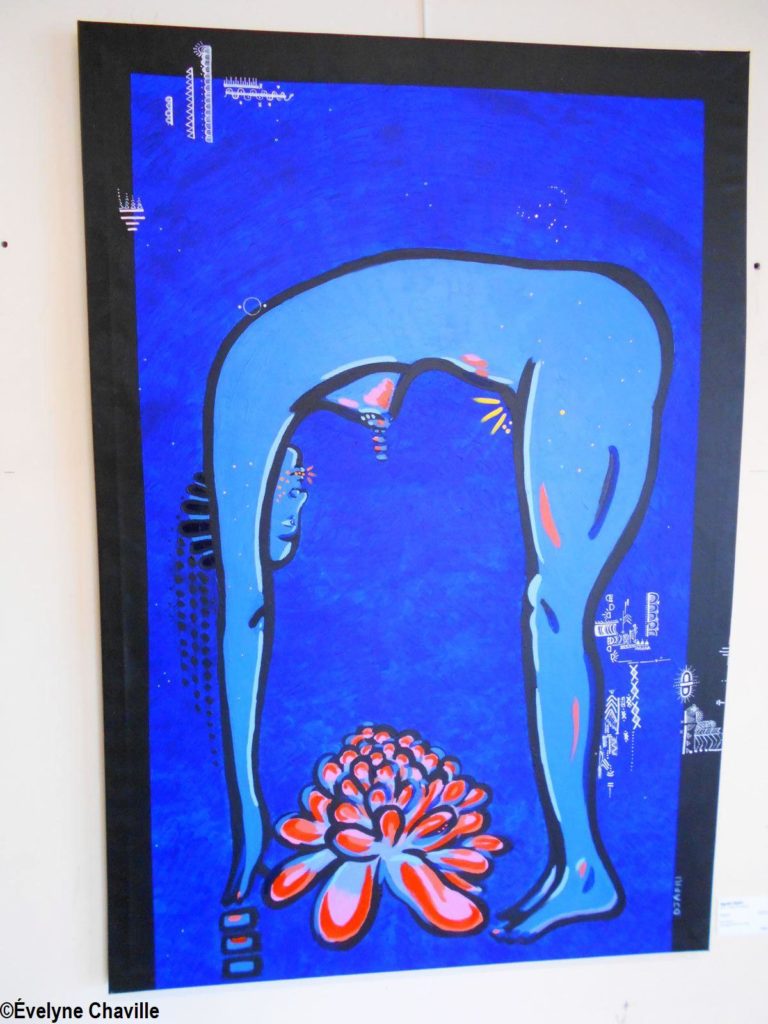
Kariculture : That was missing?
A. D. : Yes, that was missing, life went on and I was one of the few artists who dared, I was not afraid. I dared and it went really well during the two years until the end of 2021 when I went to Montreuil. I responded to an invitation from a photographer and I exhibited for three days there during the Portes Ouvertes d’Ateliers and it was also a wonderful encounters with so many different countries, it was a perpetual enrichment. So, it is the result of all this, of all these little seeds sown despite myself that today, in 2022, first semester, I will have counted almost ten exhibitions.
Kariculture : I have the impression that it is now that we really hear about Agnès Djafri…
A. D. : I’m discreet and I’m not looking for the media, when someone comes to me, I’m very happy but the main thing for me is to meet people. I progress very slowly. I restarted really slowly because after the art school, I worked in Martinique and Guadeloupe, I did exhibitions, many murals, I had a clothing brand that I painted by hand, with taïno, arawak petroglyps etc. Then I “fell” into communication, I say “fell” because communication is so time-consuming that after a few years, you look back and say : “My God, I’ve been in there too long and I’ve forgotten my brushes somewhere, they’re all dusty!” I needed to stop short, and I really stopped in 2015 everything I was doing, I gave up a prominent position in a company to get back to my brushes and prepare like a marathon runner. It was a great moment but it wasn’t my life as an artist. My first come-back exhibition was in 2018 with the Pool Art Fair. Indeed, it hasn’t been a long time since I restarted painting…
Kariculture : For how many years did you stop painting?
A. D. : Too long, let’s say a dozen years.
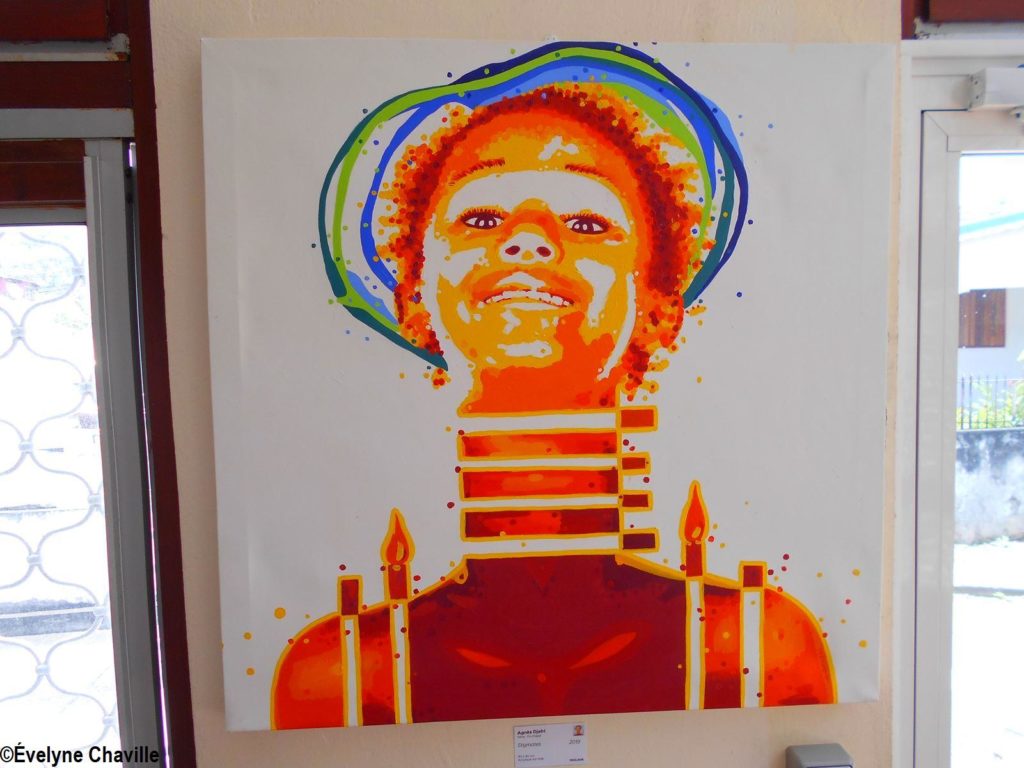
Kariculture: You didn’t paint at all?
A. D. : No, I was writing. I did little things in secret but I didn’t show anything, I didn’t share anything, at that time.
Kariculture : Let’s go back to this exhibition which represents four years of work. Water is a developed theme, why?
A. D. : Water is a recurring theme since the beginning and it will always be there because it’s something essential, it’s a vehicle and it also nourishes my philosophy of life. Don’t forget where you come from.
Kariculture : In what theme do you classify the painting entitled “Stigmates”?
A. D. : It’s about working on ourselves. In fact, when Habdaphaï (painter) suggested this theme of “Po chapé”, I scratched a little more and I went beyond saying to myself that we can’t judge people on what they think is good for them. Our history has been hidden from us for so long, we’ve only discovered it recently so we have the impression that we’re talking about it a lot, we’re still discovering it every day… So, the time we take to do things, to understand them, to understand ourselves, to know ourselves, is important, whatever the color of our skin, where we come from (…).
Kariculture : How do you define your art?
A. D. : It is a free and intuitive figuration. I don’t like to be in a box because I have the freedom to be an artist, I have this chance to be an artist, it’s not to put myself in a box (…).

Kariculture : Your favorite colors are blue and yellow and you very rarely mix colors…
A. D. : My colors are frank, raw, directly from the tube because I paint quickly, I want to say things and not let emotion carry me away (…) But sometimes, like now, I work in monochrome with quite neutral colors like gray, black, beige because it’s part of the thing I have to say. Color is very important, every moment has its color.
Kariculture : Why blue and why yellow?
A. D. : Because these are primary colors and I was, at the base of my work, on more basic things that I needed to establish. My themes, my colors, I needed to put things in a form of control to then free myself and be more in the intuition and trust what I am, what I feel, what I want to say, what I received, what I learned. I am very lucky to be Guadeloupean and to live here. I recognize my luck and even if I have other origins, today, I don’t chase them anymore because I didn’t have this transmission ; but now that I’ve let go, I’m 54 years old, I have my own calligraphy, which is important in a country like Algeria; in this civilization calligraphy is something primordial. Having let go, I see with hindsight that since high school I was drawing my own letters and I didn’t realize it, I didn’t realize that I was doing that and now I integrate them in my paintings. In my 2022 work, I integrated calligraphy, I integrated the work on words too, the meaning of words because I write a little bit, all that has grown, my work is more global with what I realize about me, my puzzle falls into place.























